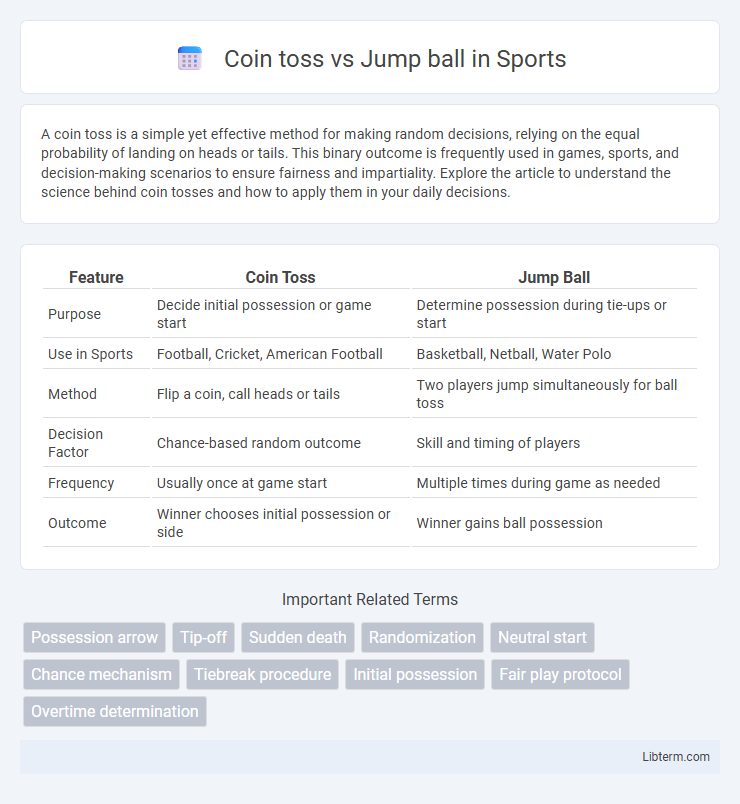A coin toss is a simple yet effective method for making random decisions, relying on the equal probability of landing on heads or tails. This binary outcome is frequently used in games, sports, and decision-making scenarios to ensure fairness and impartiality. Explore the article to understand the science behind coin tosses and how to apply them in your daily decisions.
Table of Comparison
| Feature | Coin Toss | Jump Ball |
|---|---|---|
| Purpose | Decide initial possession or game start | Determine possession during tie-ups or start |
| Use in Sports | Football, Cricket, American Football | Basketball, Netball, Water Polo |
| Method | Flip a coin, call heads or tails | Two players jump simultaneously for ball toss |
| Decision Factor | Chance-based random outcome | Skill and timing of players |
| Frequency | Usually once at game start | Multiple times during game as needed |
| Outcome | Winner chooses initial possession or side | Winner gains ball possession |
Introduction: Coin Toss vs Jump Ball
Coin toss and jump ball are two common methods used in sports to determine initial possession or restart play. Coin toss relies on chance with a simple heads-or-tails outcome, often used in football and cricket, while jump ball involves physical skill and timing between players, primarily seen in basketball. Understanding the differences highlights how each method impacts fairness and game dynamics across various sports.
Historical Background of Game Starters
The coin toss and jump ball have distinct historical origins as methods to start basketball games, reflecting the evolution of the sport's rules since the late 19th century. The jump ball, introduced by James Naismith in 1891, was designed to fairly initiate play by having two opposing players compete for possession at center court. The coin toss, although less common in professional basketball, has historically been used to decide possession in tied games or to determine initial possession in casual or alternative formats, highlighting its role in sports as a simple chance-based starter.
Rules and Procedures: Coin Toss
The coin toss serves as the primary method to determine initial possession in sports like football, where a neutral official flips a coin between team captains before the game starts. The visiting team captain calls heads or tails while the coin is in the air, with the winner choosing to either receive the ball or defer their choice to the second half. This simple procedure ensures fairness by providing an equal 50/50 chance for either team to gain the initial advantage in possession.
Rules and Procedures: Jump Ball
The jump ball in basketball starts with the referee tossing the ball into the air between two opposing players, who then attempt to tap it to a teammate to gain possession. According to NBA rules, jump balls are used at the start of the game, overtime periods, and certain situations where simultaneous possession occurs. Players must remain within the circle and may only tap the ball once before it touches another player or the floor, ensuring fair contest and possession.
Sports Utilizing Coin Toss
Sports utilizing coin tosses primarily include football (NFL) and cricket, where the coin toss determines initial possession or batting order, influencing game strategy. Unlike jump balls used in basketball to start play or settle possession disputes, coin tosses rely on pure chance to ensure fairness in decision-making. This method is favored in sports like American football and cricket for its speed and impartiality in setting the stage for gameplay.
Sports Utilizing Jump Ball
Sports utilizing jump ball methods, such as basketball and netball, rely on the skill-based contest at the start or during play to determine possession, contrasting with the random chance outcome of a coin toss seen in sports like cricket or American football. The jump ball requires timing, vertical leap capability, and hand-eye coordination, emphasizing athletic ability in gaining initial control. This method enhances competitive fairness by allowing players to directly influence possession outcomes rather than relying on luck.
Fairness and Objectivity Comparison
Coin toss ensures fairness and objectivity by providing a 50/50 chance between two outcomes through a random physical event, minimizing bias in decisions like game starts. Jump ball relies on human factors such as timing, height, and reflexes, introducing variability that may affect fairness despite its competitive nature. Statistical analyses favor coin tosses for unbiased results, while jump balls can advantage taller or more agile players, impacting objectivity in sports settings.
Strategic Implications for Teams
Coin toss and jump ball each have unique strategic implications in sports; coin toss outcomes determine initial possession, directly influencing early game tempo and field positioning decisions. Jump ball situations require players to execute timing and vertical leap tactics, impacting immediate control over the ball and potentially shifting momentum swiftly. Coaches tailor strategies to optimize possession gains from these events, aligning player roles and formations for advantageous game flow.
Controversies and Debates
Controversies surrounding coin tosses primarily involve their perceived randomness and fairness in deciding crucial moments in sports or elections, with critics arguing they reduce complex decisions to pure chance. Jump balls face debates related to officiating bias and the strategic advantage granted to taller or more skilled players, raising questions about equitable game starts. Both methods spark ongoing discussions about fairness, transparency, and the best mechanisms to ensure impartial outcomes in competitive environments.
Future Trends in Game Initialization
Future trends in game initialization highlight increased use of technology for fairness and speed, potentially replacing traditional coin tosses and jump balls with digital randomizers and AI-based refereeing systems. Virtual and augmented reality platforms may introduce immersive pre-game rituals that enhance spectator engagement and player readiness. Integration of blockchain technology could provide transparent, tamper-proof verification of initial game outcomes, ensuring integrity in competitive sports.
Coin toss Infographic

 libterm.com
libterm.com